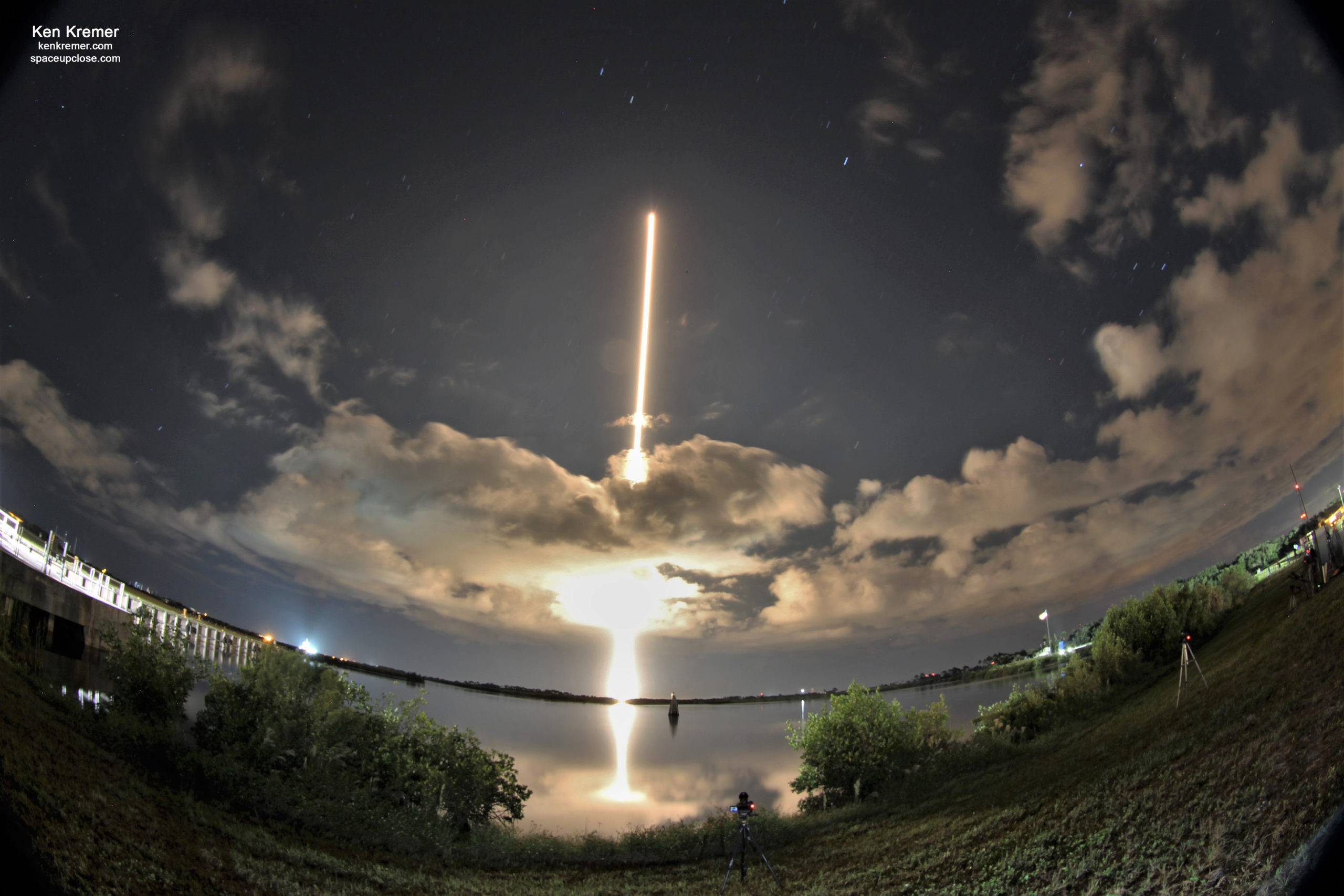
For SpaceUpClose.com & RocketSTEM
KENNEDY SPACE CENTER/CAPE CANAVERAL SPACE FORCE STATION, FL – NASA’s lovely Lucy asteroid expedition spacecraft launched into the dark predawn skies Saturday, Oct. 16 on a United Launch Alliance (ULA) Atlas V Carrier rocket from Florida’s Space Coast on a historic 1st ever trek to traverse and explore Jupiter’s pristine Trojan asteroids.
With many singing and dreaming about ‘Lucy in the Sky with Diamonds’ – the classic Beatles hit song adopted by the mission team as a guiding light and imprinted on a plaque on board- the history making probe lifted off flawlessly on the Atlas V and is now underway beginning a 12 year long, 4 Billion mile (6.4 billion km) revolutionary quest of exploration and discovery on a once-in-a-lifetime trajectory while encountering seven different unexplored Trojan asteroids as well as one main belt asteroid along the interplanetary way.
The $981 million Lucy craft blasted off right on time at the opening of the launch window at 5:34 a.m. EDT (0934 GMT) on Saturday, Oct. 16, 2021, just before sunrise on a ULA Atlas V rocket from Space Launch Complex 41 at Cape Canaveral Space Force Station in Florida.
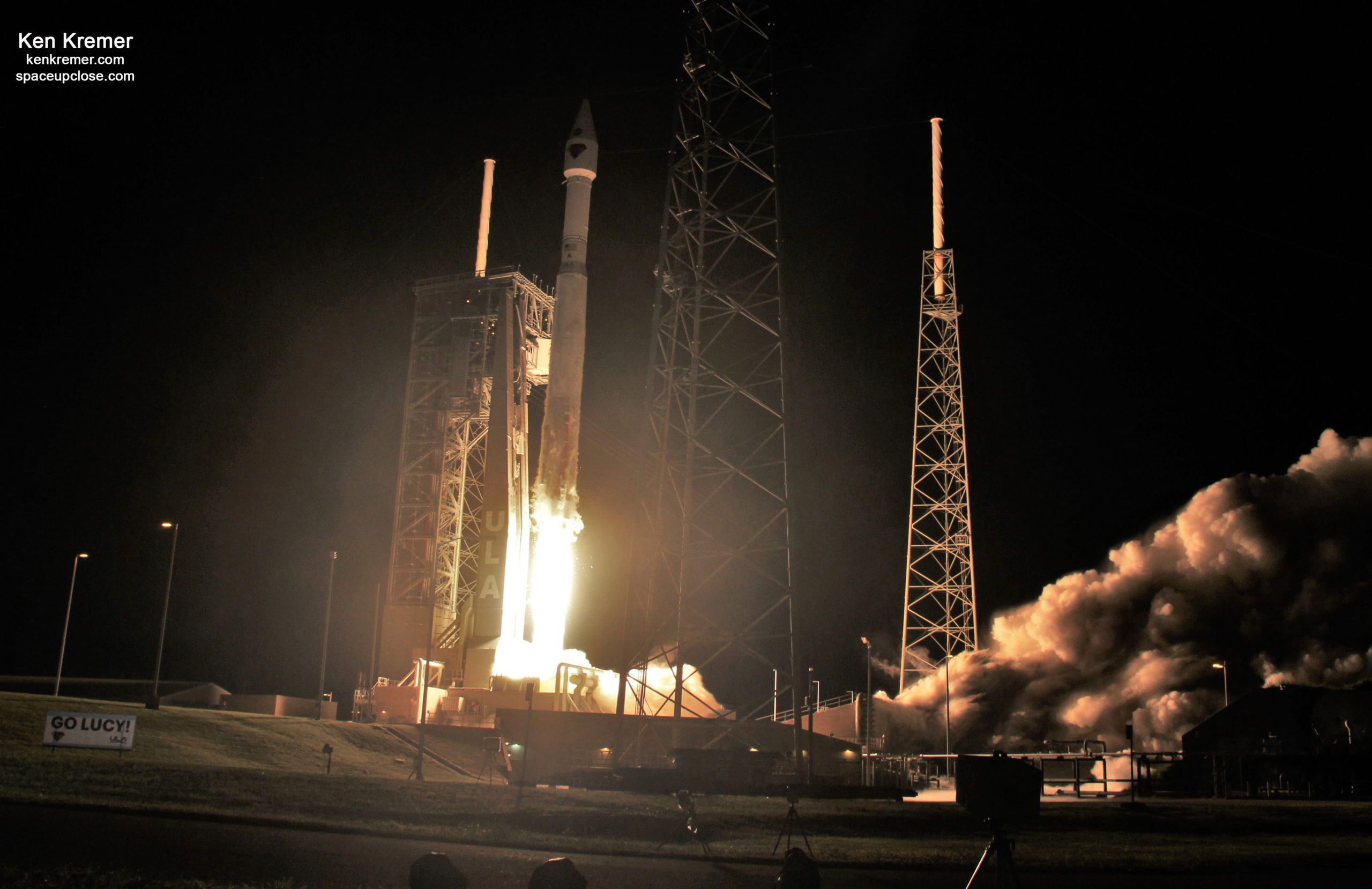
“Lucy embodies NASA’s enduring quest to push out into the cosmos for the sake of exploration and science, to better understand the universe and our place within it,” said NASA Administrator Bill Nelson, in a statement.
“I can’t wait to see what mysteries the mission uncovers!”

Lucy separated from the Atlas V rockets Centaur upper stage 58 minutes after liftoff after completing two burns by the rocket’s Centaur upper stage.
Applause is heard in the @ULALaunch control room as the #LucyMission spacecraft successfully separates. Up next: deployment of the two 24-foot (7-meter) solar arrays. pic.twitter.com/o26YqHpQ9G
— NASA (@NASA) October 16, 2021
The spacecraft deployed its two cymbal shaped solar arrays – each nearly 24 feet (7.3 meters) wide –during a 20-minute procedure that started about 30 minutes later after separation from the Centaur.
Lucy is healthy “and began charging the spacecraft’s batteries to power its subsystems” NASA reported.
“Lucy sent its first signal to Earth from its own antenna to NASA’s Deep Space Network at 6:40 a.m. The spacecraft is now traveling at roughly 67,000 mph (108,000 kph) on a trajectory that will orbit the Sun and bring it back toward Earth in October 2022 for a gravity assist.”
Lucy will be the most distant solar powered spacecraft.
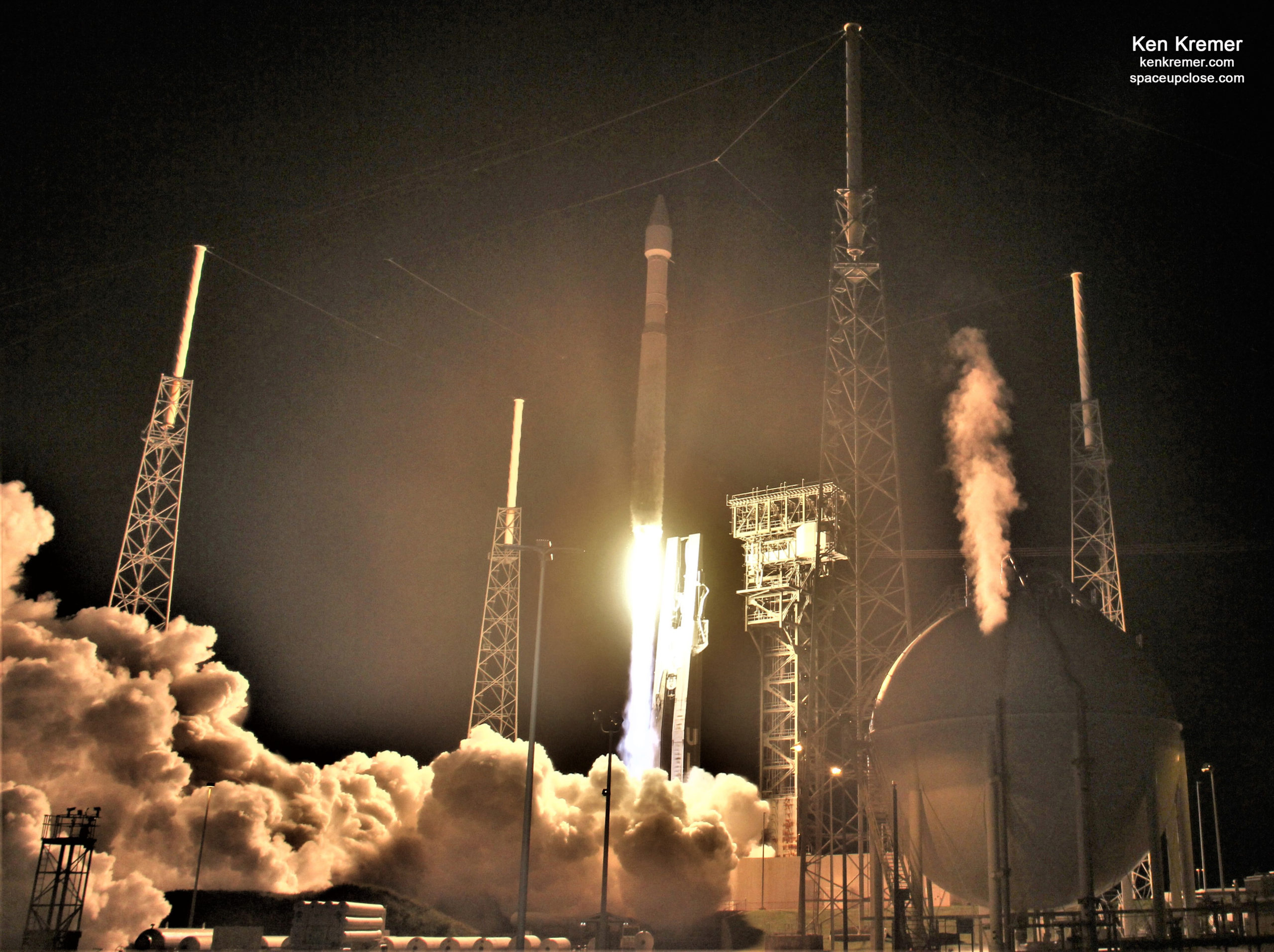
Lucy blasted off into a partly cloudy night sky with near perfect weather conditions and quickly pieced a thick layered low cloud deck and then reemerged heading skyward on a southerly trajectory away from Florida and then arcing over to Africa – starting its science sojourn to the outer solar system.
Large crowds gathered around the space coast at beaches, roadways, restaurants and parks to cheer Lucy on her groundbreaking science mission.

The Trojans are fossilized remnants which scientists will study to help us better understand the history of us – via new clues and insights into the birth and evolution of our Solar System of these primitive celestial bodies.
“Today’s launch marks a genuine full-circle moment for me as Lucy was the first mission I approved in 2017, just a few months after joining NASA,” said Thomas Zurbuchen, associate administrator for the Science Mission Directorate at the agency’s Headquarters in Washington, in a statement.
“A true mission of discovery, Lucy is rich with opportunity to learn more about these mysterious Trojan asteroids and better understand the formation and evolution of the early solar system.”
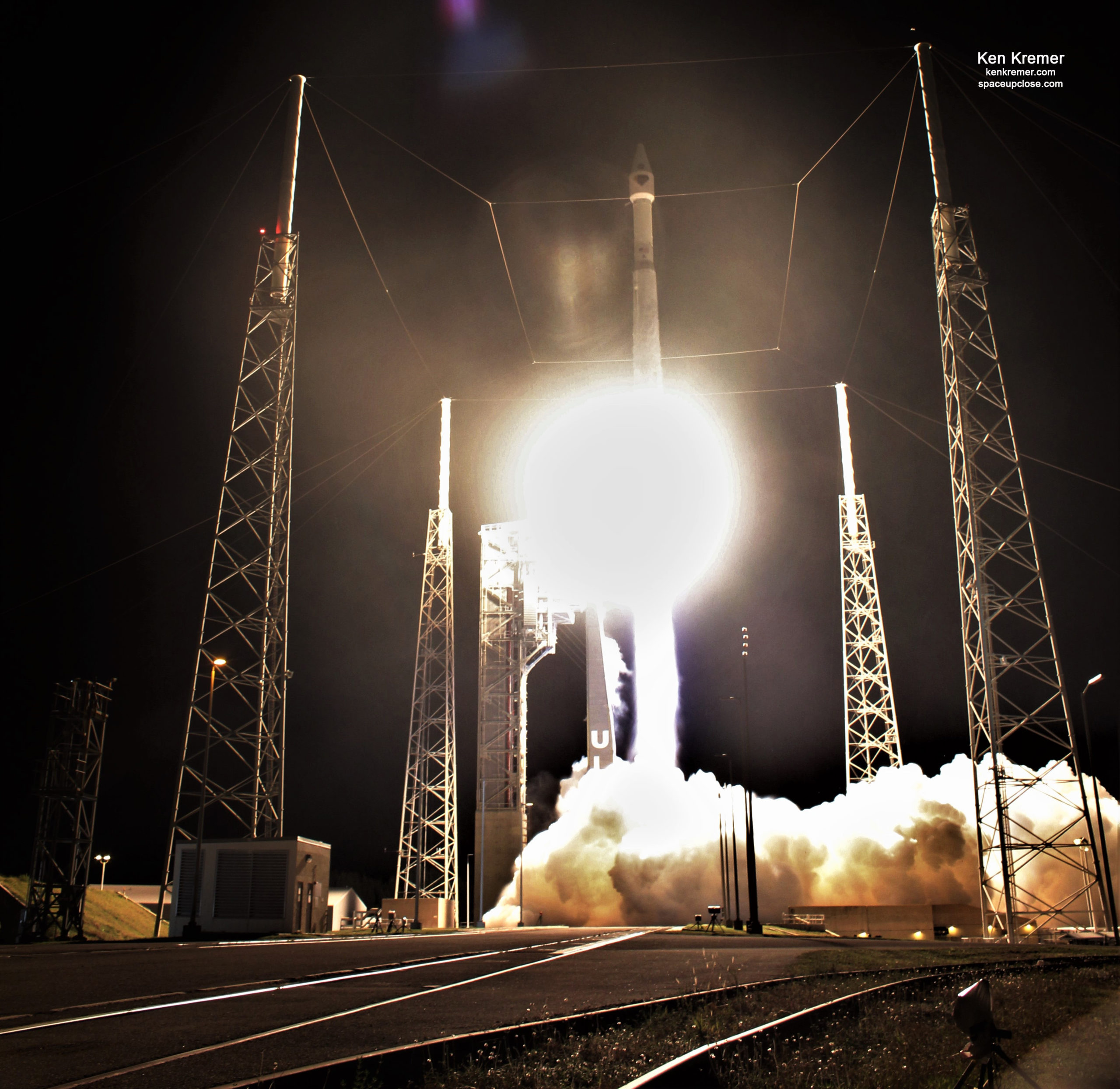
With the Atlas V due to be replaced in coming years by the Vulcan Centaur rocket under development by ULA, Lucy also marks the final planetary mission for the venerable and 100% successful rocket.
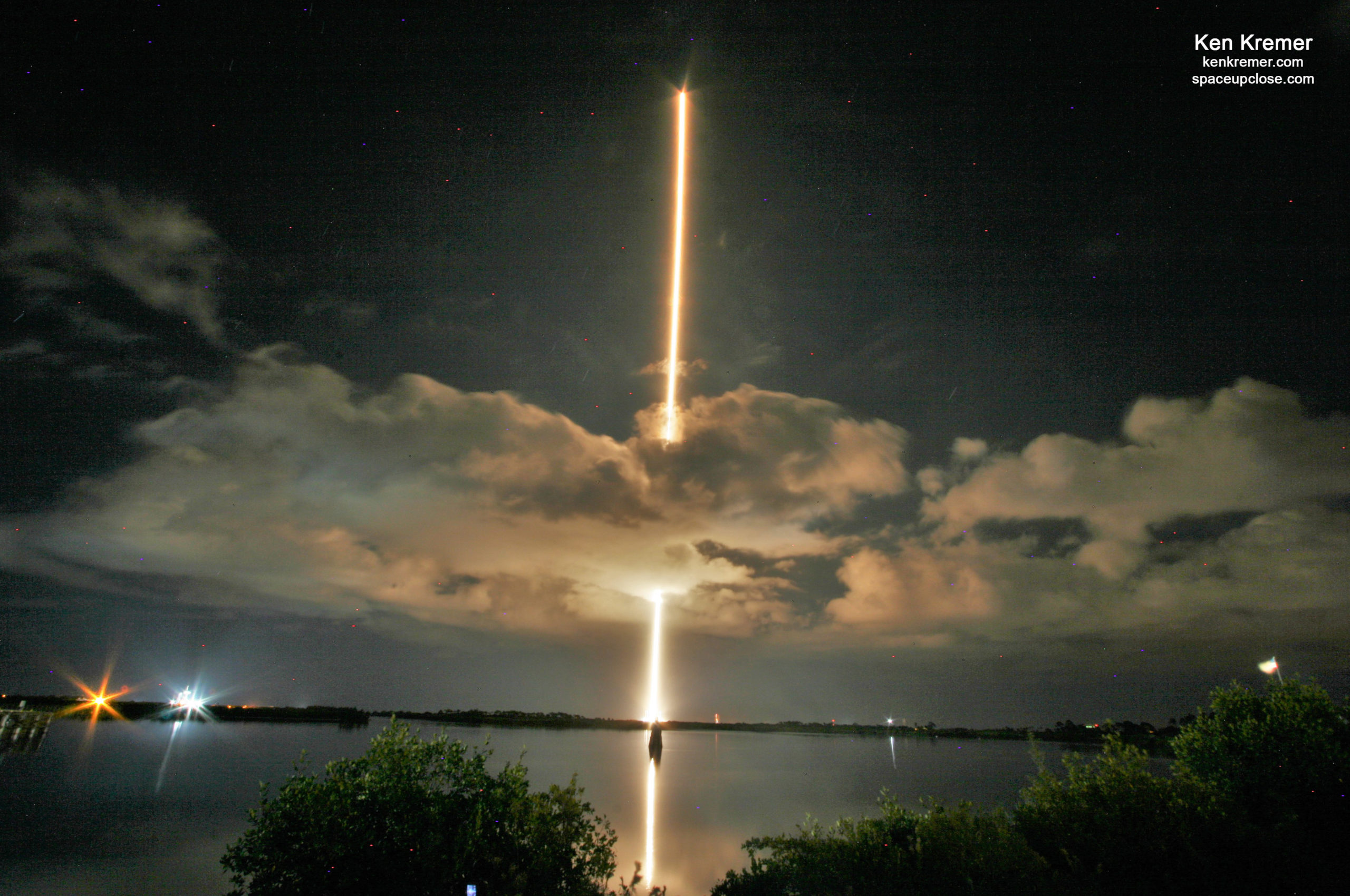
Lucy is the first science probe from Earth aiming to explore Jupiter’s pristine Trojan asteroids – fossilized remnants leftover from the birth of our Solar System some 4.5 Billion years ago and sharing Jupiter’s orbit.
NASA’s Lucy is an ambitious probe unprecedented in scope utilizing a ‘once-in-a-lifetime planetary launch window’ that will explore seven pristine Trojan asteroids orbiting ahead of and behind Planet Jupiter at the L4 and L5 Lagrange points and one main belt asteroid during a mission spanning 12 years.
Like the mission’s namesake – the fossilized human ancestor, “Lucy,” whose skeleton provided unique insight into humanity’s evolution – Lucy will revolutionize our knowledge of planetary origins and the formation of the solar system some 4.5 Billion years ago.
“We started working on the Lucy mission concept early in 2014, so this launch has been long in the making,” said Hal Levison, Lucy principal investigator, based out of the Boulder, Colorado, branch of Southwest Research Institute (SwRI), which is headquartered in San Antonio, in a statement.
“It will still be several years before we get to the first Trojan asteroid, but these objects are worth the wait and all the effort because of their immense scientific value. They are like diamonds in the sky.”
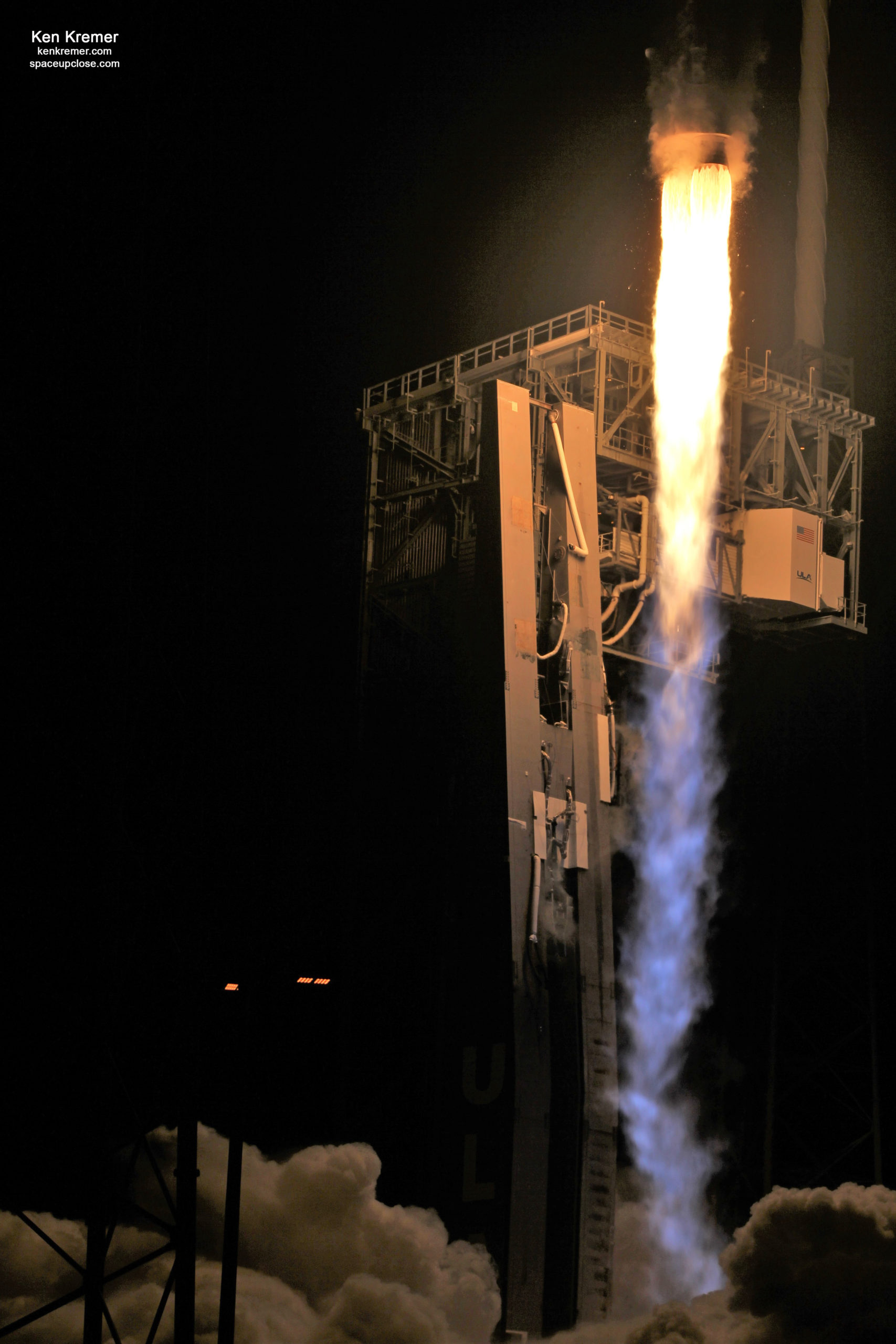
Enjoy our gallery of launch photos of NASA’s Lucy as well prelaunch atop the United Launch Alliance (ULA) carrier rocket taken during our media remote camera setup Friday morning as well as during rollout to pad 41 on Tuesday morning on Cape Canaveral Space Force Station by the Space UpClose team of Ken Kremer and Jean Wright.
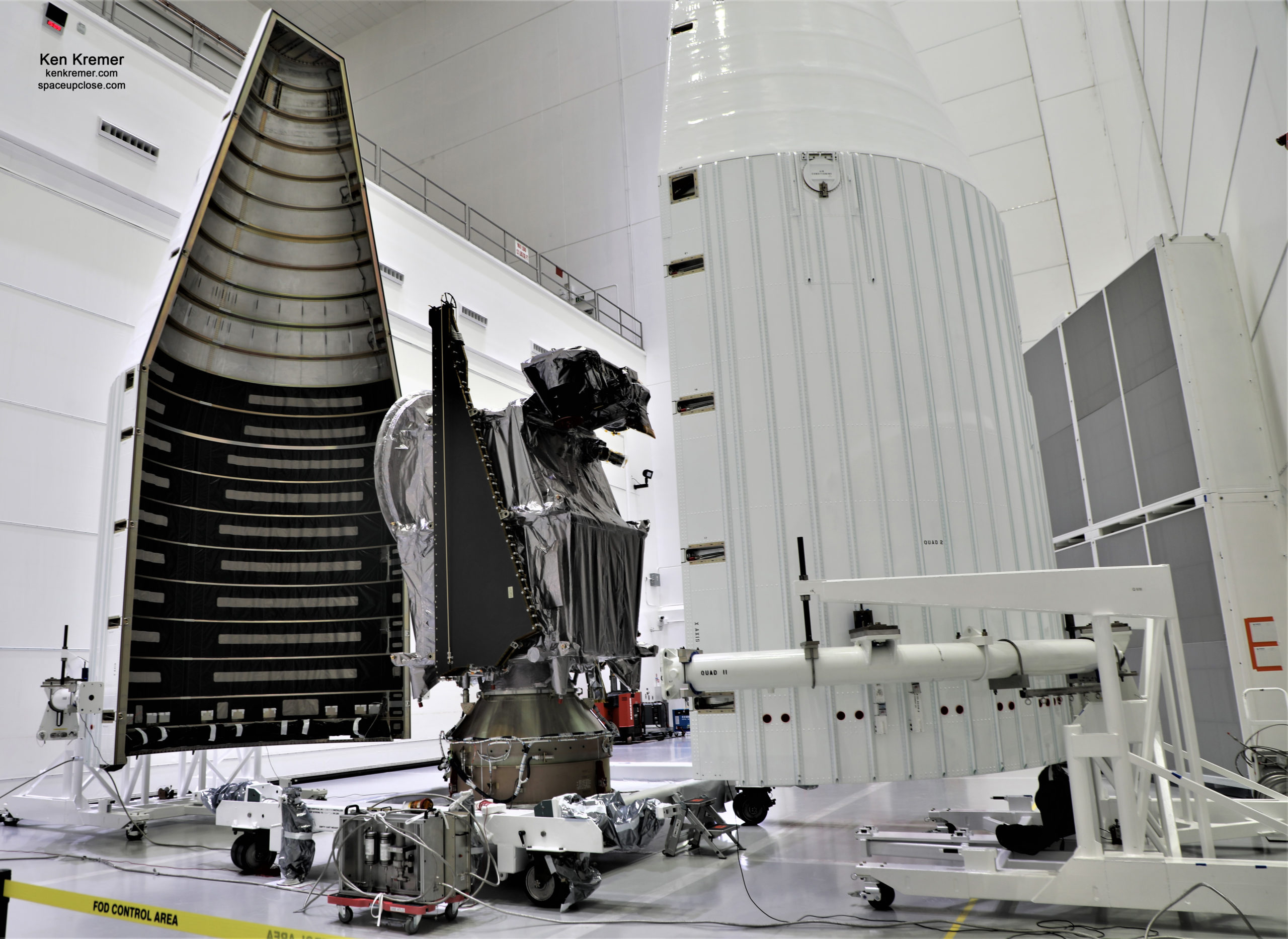
Read our full stories about the Lucy mission and goals and the cleanroom visit as well as the Atlas V rocket rollout photo gallery story and the up close with Atlas V launch pad photo gallery story here.
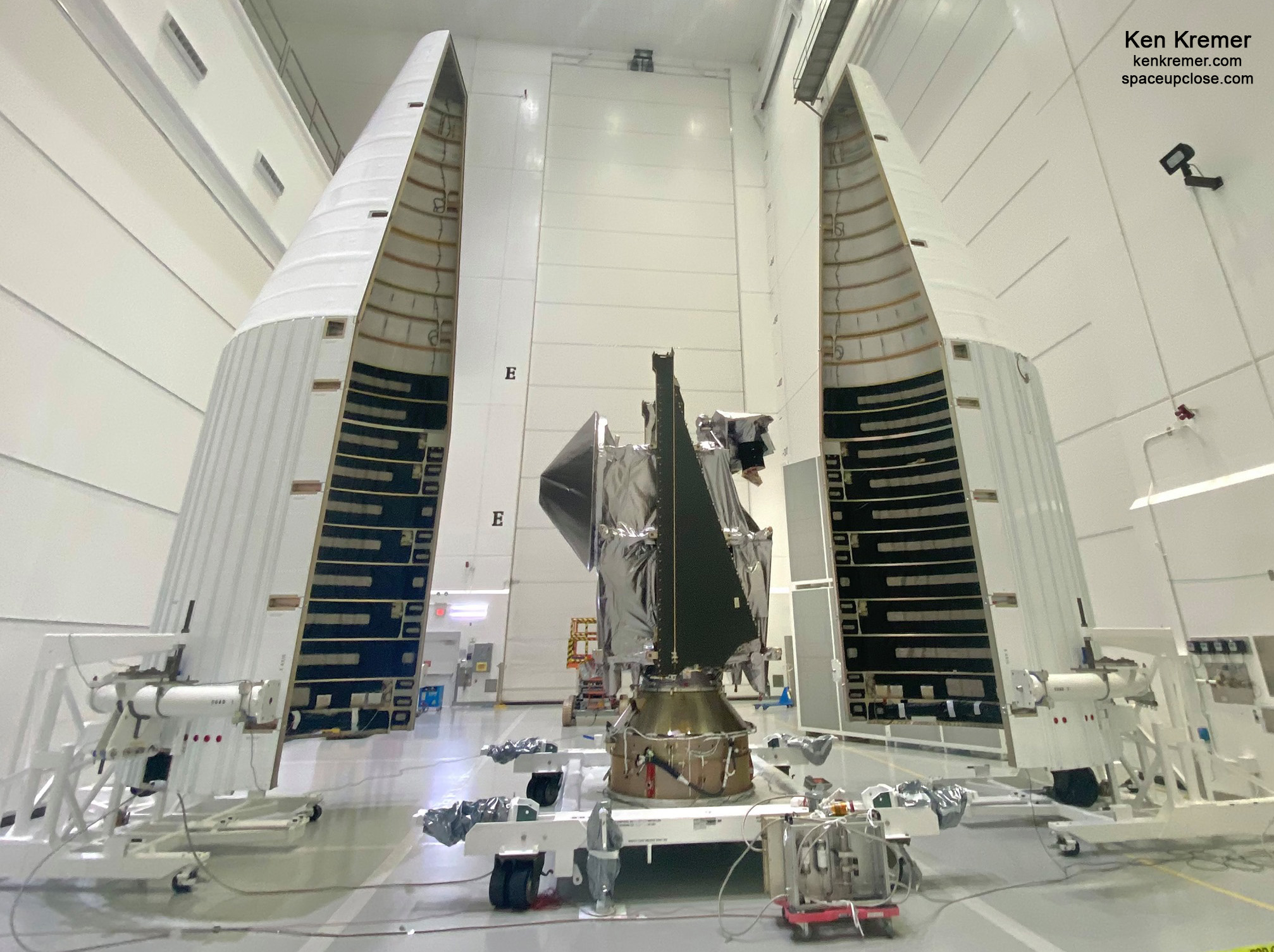
The Trojan asteroids are believed to be comprised of the initial material that formed the planets within the solar system.
"It's really important to understand solar system formation to understand where we came from."#LucyMission Deputy Principal Investigator Cathy Olkin elaborates on the significance of studying the Trojan Asteroids: pic.twitter.com/83MNOvExPd
— NASA (@NASA) October 16, 2021
No other space mission in history has been launched to as many different destinations in independent orbits around the Sun!
Lucy’s 5 Deep Space Maneuvers and 3 Earth Gravity Assists will keep the spacecraft on target!
Watch this NASA visualization:
#CountdowntoLaunch! 11 days until the start of the #LucyMission's epic voyage! In order for Lucy to explore 6 asteroid systems over 12 years, we will need to drive the spacecraft. Lucy's 5 Deep Space Maneuvers and 3 Earth Gravity Assists will keep the spacecraft on target! pic.twitter.com/wKGEGYUDaJ
— Lucy Mission (@LucyMission) October 5, 2021
Here is a detailed outline of the Lucy asteroid flyby tour:
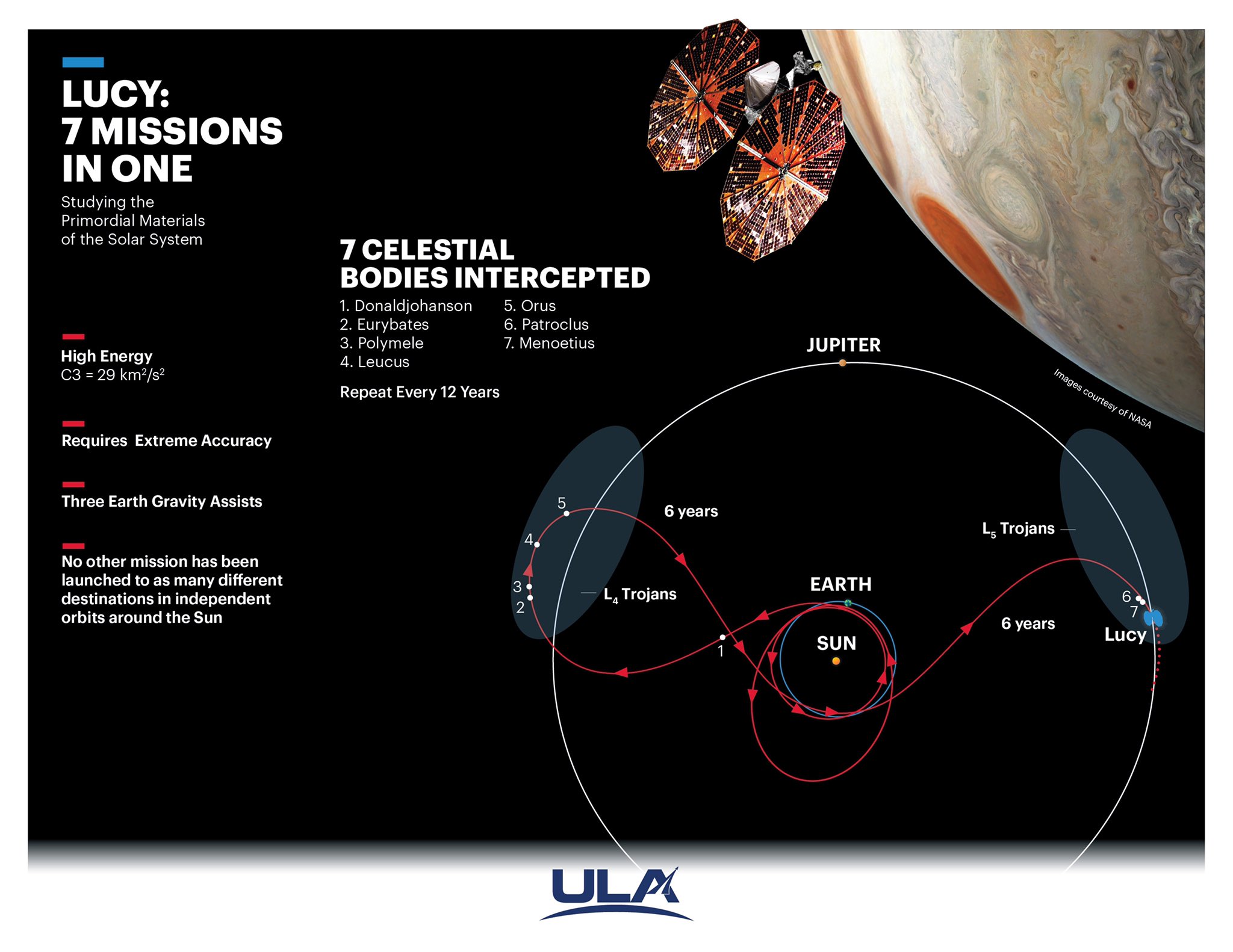
After launching on the Atlas V in Oct 2021, Lucy will carry out two Earth flyby maneuvers in Oct 2022 and Dec 2024 to set up the asteroid flyby tour.
Then it will fly by a main belt asteroid Donaldjohanson in April 2025 named after the discoverer of the Lucy fossil in Ethiopia – paleoanthropologist Donald Johanson.
Watch this NASA interview with Donald Johanson as we witnessed the launch at NASA’s Kennedy Space Center and describing how the Lucy fossil was found and named after the Beatles song.
"To be out here this morning is absolutely mind-expanding… to see what the creativity of the human mind can do."
Paleoanthropologist Donald Johanson, who found the fossil for which the #LucyMission is named, reflects on launch & the origin of the name: https://t.co/tWQwAG6AaC pic.twitter.com/MDZKHcYsSW
— NASA (@NASA) October 16, 2021
The Trojan asteroid flyby’s begin in the L4 swarm in August 2027 leading Jupiter with a total of 5 asteroid encounters, one of which is a binary, and continuing for 15 months into 2028 through November.
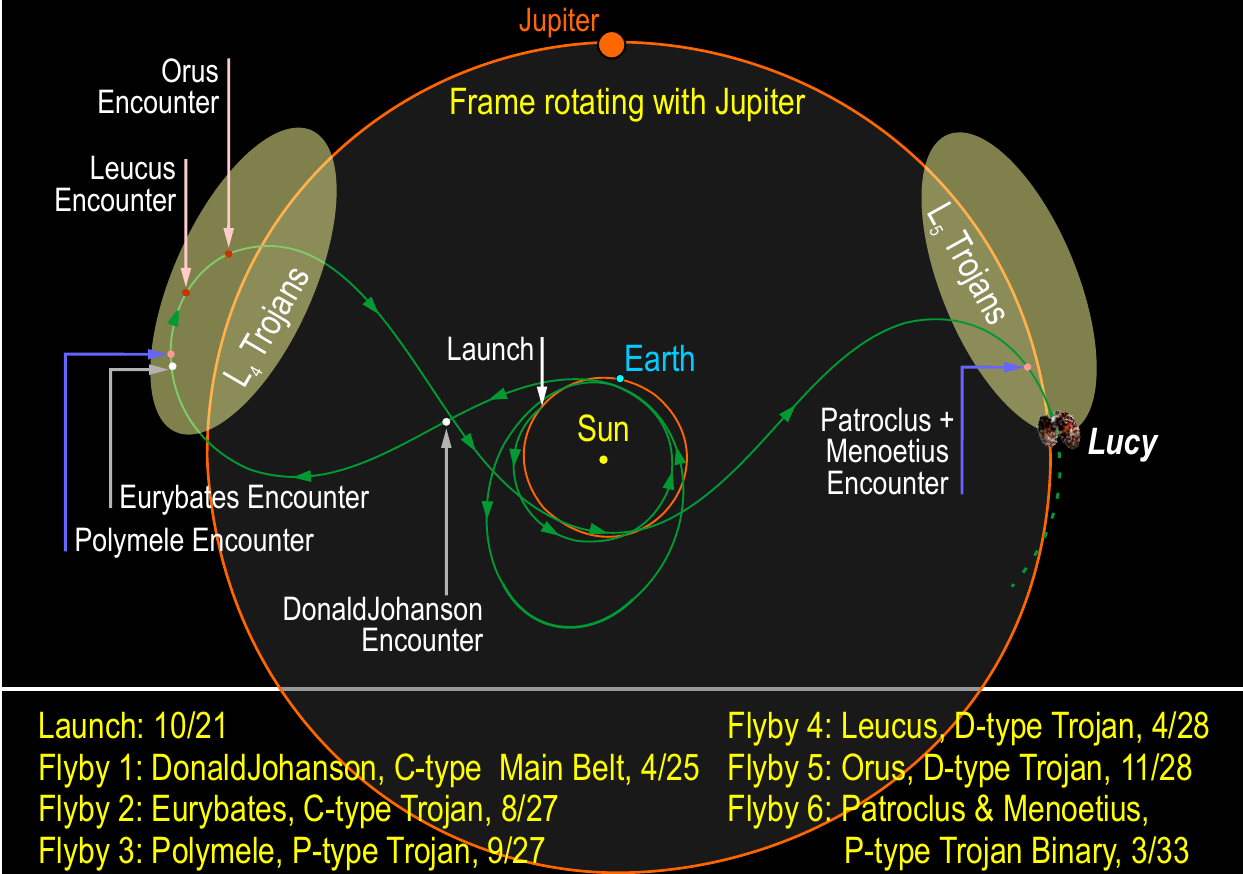
During the 4156 day mission Lucy will investigate seven Trojan asteroids, which lead and follow Jupiter in its orbit by roughly 60 degrees and one main belt asteroid that “hold vital clues to the history of the Solar System.”
The Trojans are clustered in two “swarms” of asteroids at the L4 and L5 Lagrange points centered 60 degrees ahead of and behind massive Jupiter in its path around the Sun as the largest planet on our Solar System.
These asteroids are thought to be remnants of the initial material that formed the planets within the solar system.
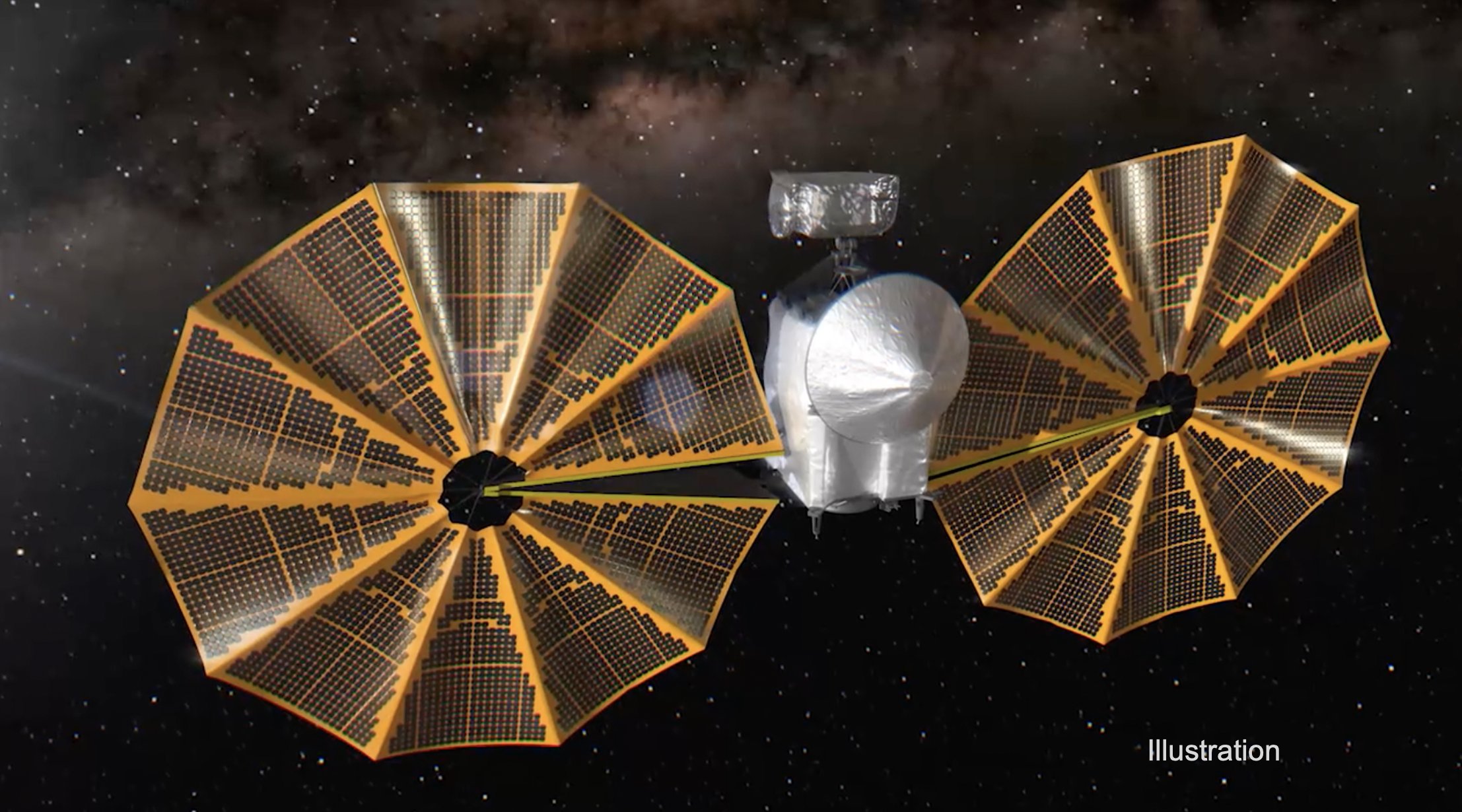
Lucy is equipped with a payload of three science instruments which are mounted on the Instrument Pointing Platform (IPP).
The science payload is comprised of L’Ralph, L’Lorri and L’TES.
- L’Ralph (composed of the Multi[1]spectral Visible Imaging Camera, MVIC – the color visible imager, and the Linear Etalon Imaging Spectral Array, LEISA – the infrared imaging spectrometer).
- L’LORRI (LOng Range Reconnaissance Imager – the high spatial resolution imager).
- L’TES (Thermal Emission Spectrometer – for measuring the thermal infrared), and T2CAM (Terminal Tracking CAMera, visible imager for navigation.
They will gather measure about geology, chemical composition, color, physical properties, shapes, masses as well as to look for moons and rings during each fast flyby – taking place at about 15,000 MPH.
The probe will flyby each target Trojan asteroid within about 600 miles (965 kilometers).
They range in size from about 10 (16 km) to 70 miles (113 km) across.
“Are there mountains? Valleys? Pits? Mesas? Who knows? I’m sure we’re going to be surprised,” said Johns Hopkins University’s Hal Weaver, PI for the L’LOORI black-and-white camera, at a media briefing.
“But we can hardly wait to see what … images will reveal about these fossils from the formation of the solar system.”
The Atlas V rocket with the Lucy spacecraft aboard stands 188 feet (57.3 meters) tall and weighed 742,913 pounds (336,980 kg) at liftoff.
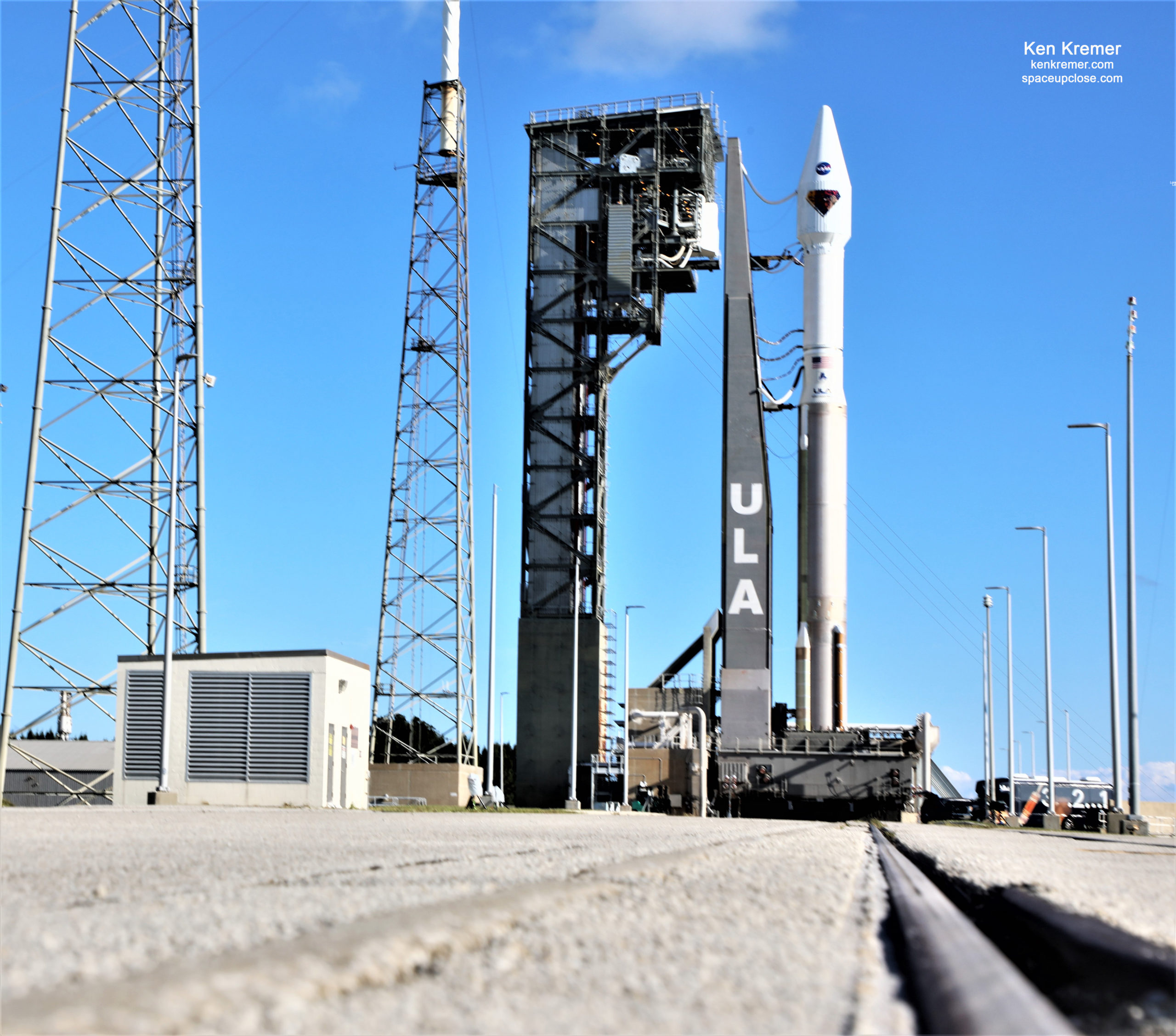
Lucy launched on an Atlas V 401 configuration rocket, that includes a 14-ft (4-m) diameter large payload fairing (LPF) and stands 188 ft (57.3 m) tall.
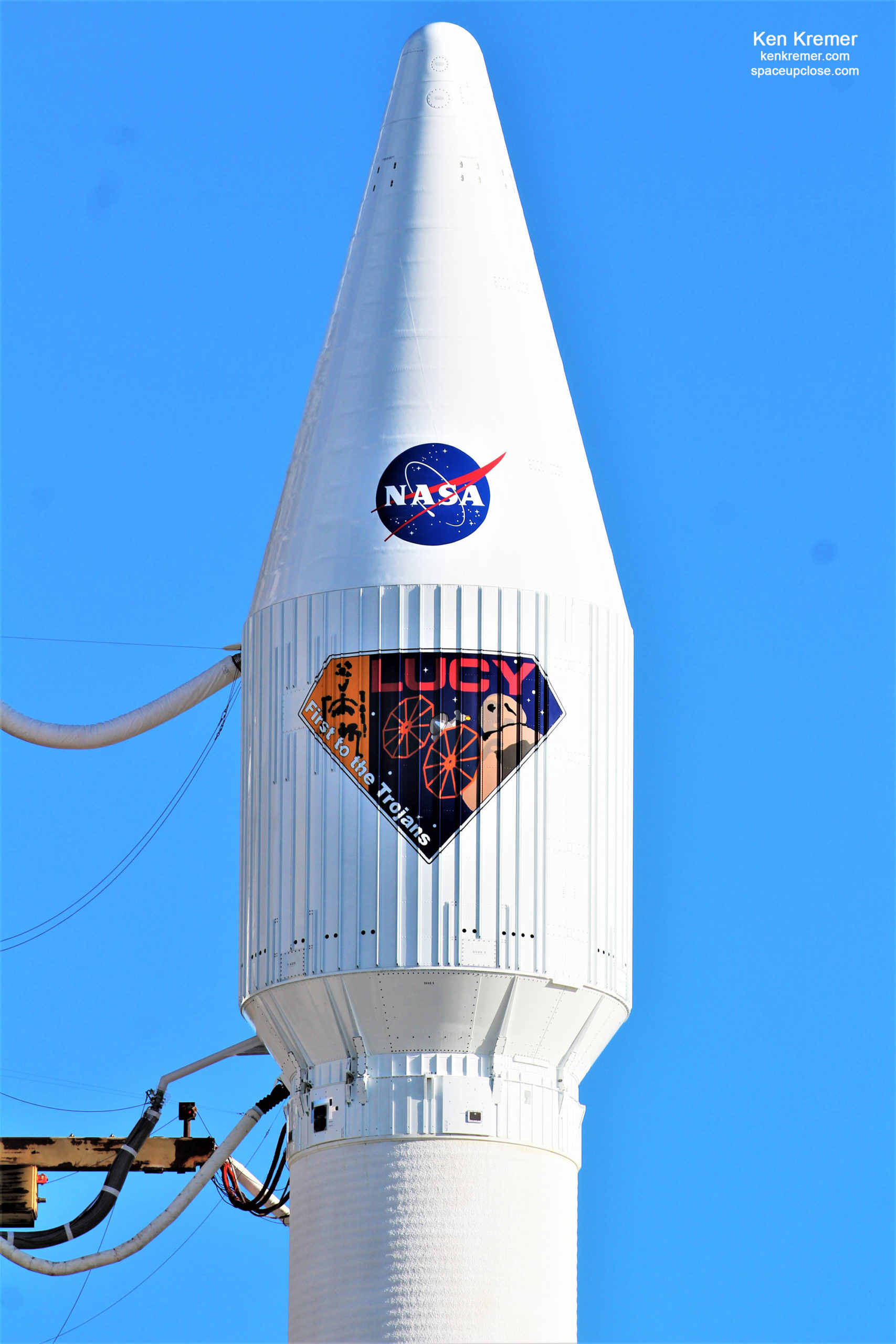
The Atlas booster for this mission is powered by the RD AMROSS RD-180 dual chamber single engine which provides 860,000 lbs liftoff thrust fueled by RP-1 and LOX propellants and with no thrust augmentation from first stage solid rocket boosters.
NASA and ULA officials told Space UpClose that adding solids would potentially put excessive stress on the spacecraft
Aerojet Rocketdyne provided the RL10C-1 engine for the Centaur upper stage to which Lucy is attached until payload separation and provides 22,900 lbs thrust fueled by LOX and LH2 propellants.
ULA CEO Tory Bruno eloquently explains why they invented RAAN steering for #AtlasV rocket launching NASA’s #LucyMission-which increases launch window from 1sec to 4500sec or 75min! “& still intercept correct interplanetary trajectory” to explore record breaking 7 Trojan asteroids
#ToryTalk // RAAN steering is part of ULA's secret sauce to achieve the most accurate orbital insertions in the industry. @ToryBruno explains how #AtlasV will be able to launch #LucyMission any time within the launch window & still intercept the correct interplanetary trajectory. pic.twitter.com/4o1TAJG6eM
— ULA (@ulalaunch) October 15, 2021
The Lucy mission is the 89th launch of the Atlas V rocket and marks the 100th launch from SLC-41 at Cape Canaveral Space Force Station.
To date including Lucy ULA has launched 146 times with 100 percent mission success.
Lucy is a Discovery class mission led by principal investigator Harold “Hal” Levison from the Southwest Research Institute in Boulder, Colorado.
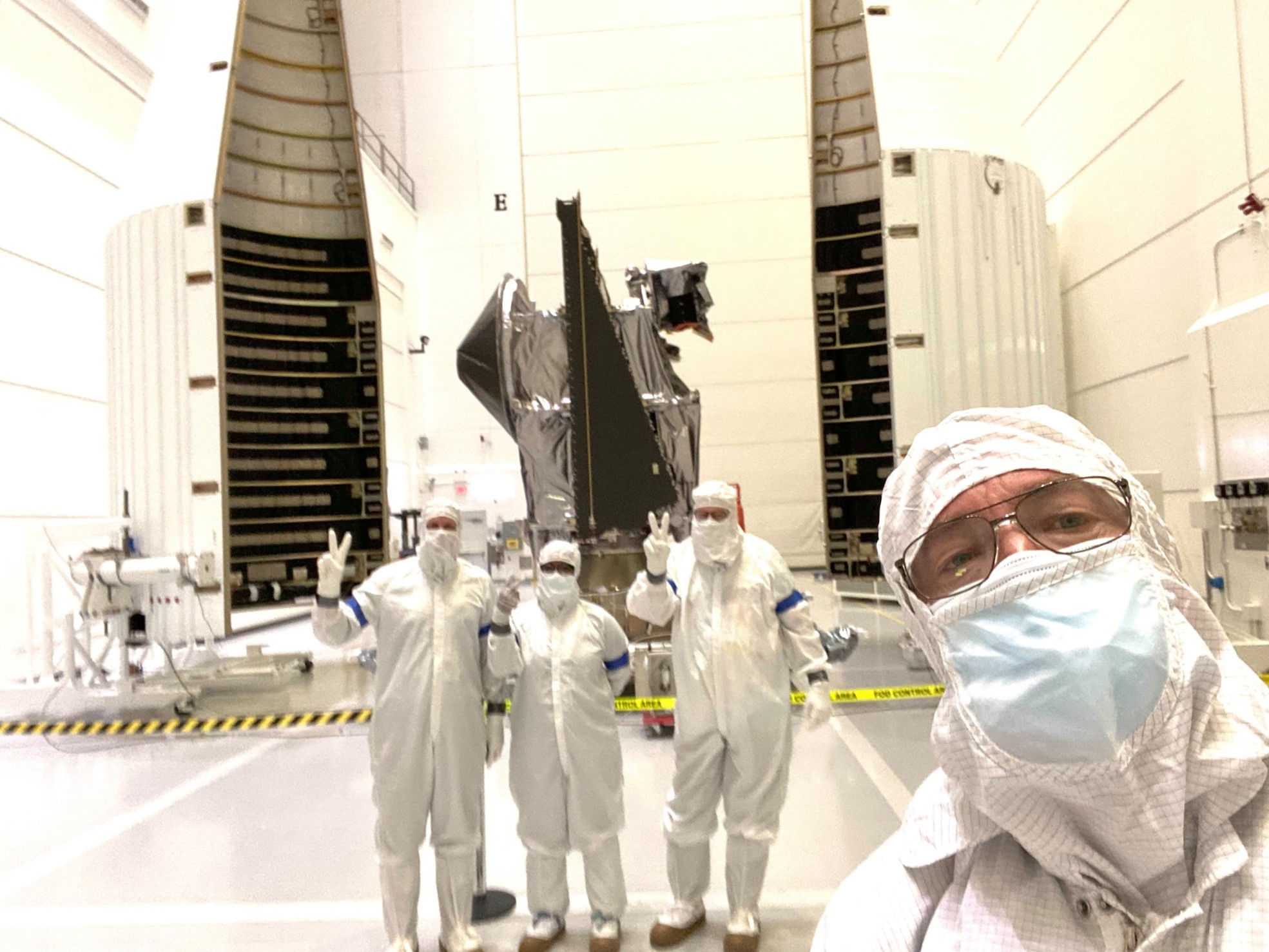
Lockheed Martin Space in Littleton, Colorado, is prime contractor for the Lucy mission and built the spacecraft.
Southwest Institute (SwRI) in Boulder, Colorado is the principal investigator institution for the Lucy Mission and will lead the science investigation. NASA’s Goddard Space Flight Center, Greenbelt, Maryland will provide overall mission management, systems engineering, and safety and mission assurance. Lockheed Martin Space Systems in Denver, Colorado built the spacecraft.
My photos of Lucy in the clean room have been featured on WFTV ABC 9 Orlando in multiple broadcasts leading up to launch
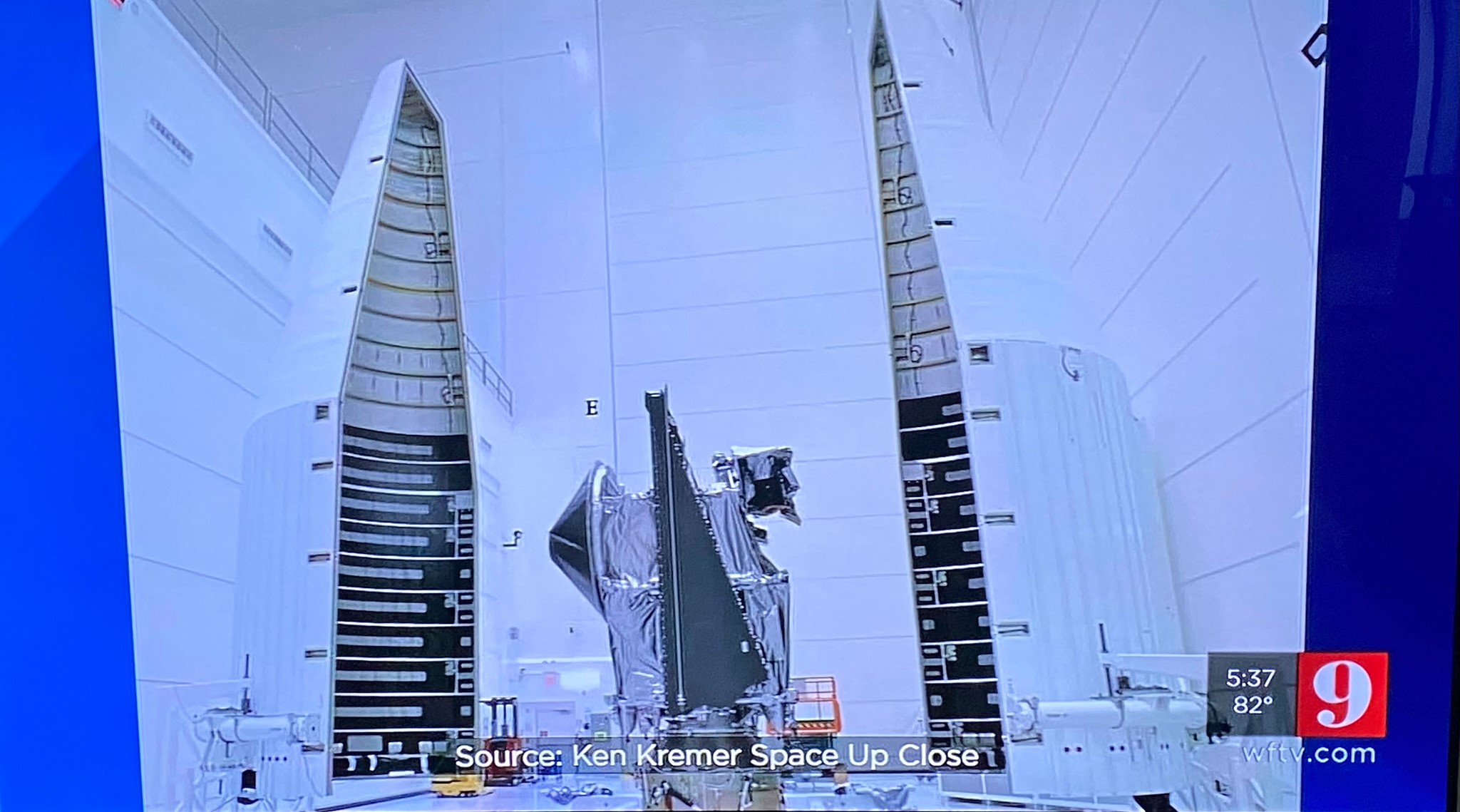
My rollout and cleanroom photos have been featured on WKMG CBS 6 Orlando in multiple broadcasts leading up to launch.
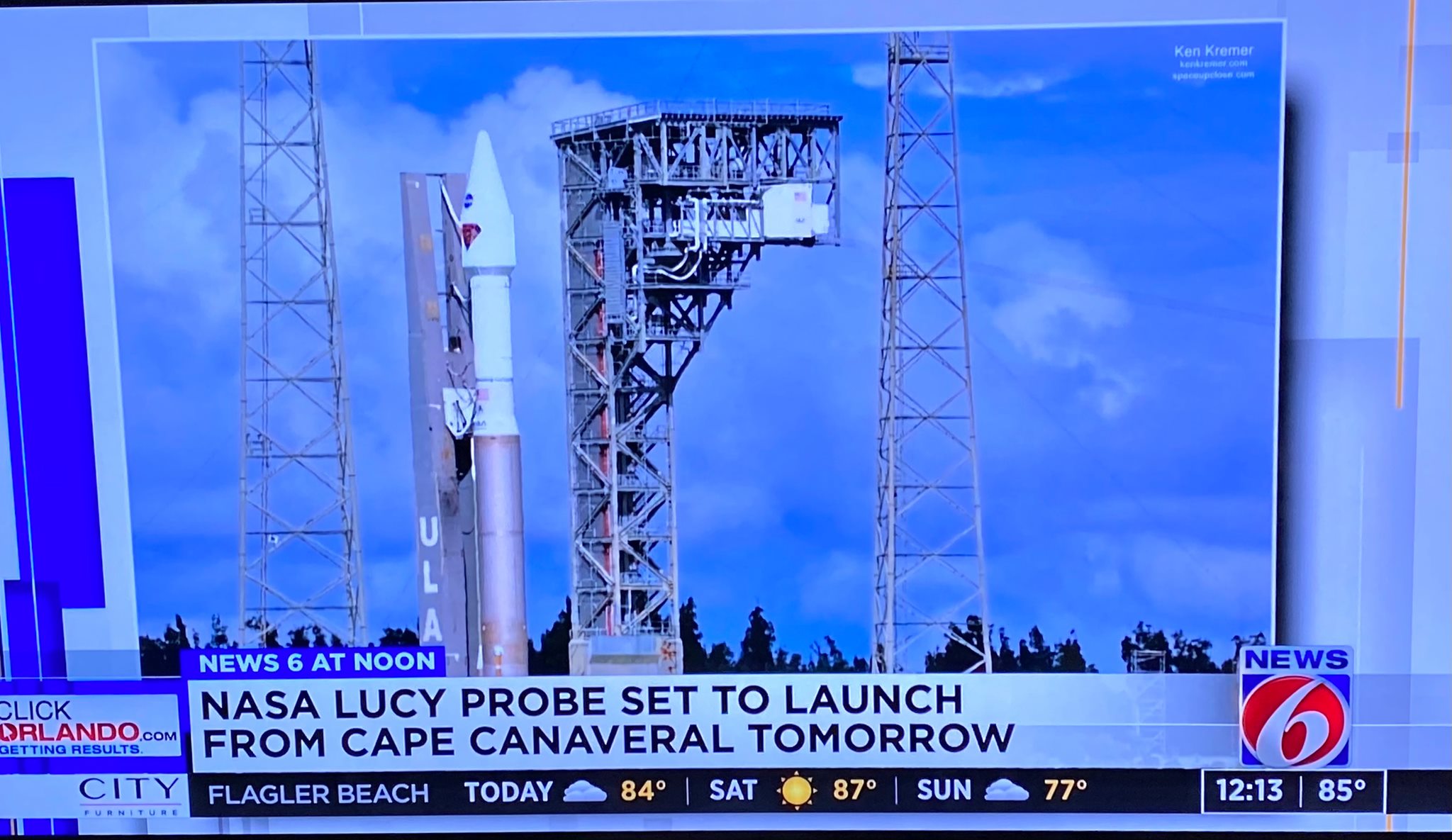
You can watch my new prelaunch interview presentation about the Lucy mission on the Oct. 6 edition of the ‘Stay Curious’ space show from the American Space Museum, Titusville, Florida – including many of my cleanroom photos – see video below.
https://www.facebook.com/SpaceWalkOfFame/videos/686060975688731
Ken is onsite at NASA’s Kennedy Space Center for live reporting about the Lucy mission
Watch Ken’s continuing reports about Lucy Asteroid mission, Blue Origin and Space Tourism, SpaceX Cargo and Crew Dragons, Artemis and NASA missions, SLS, Orion, SpaceX Starlink, Commercial Crew and Starliner and Crew Dragon and onsite for live reporting of upcoming and recent SpaceX and ULA launches including Crew 1 & 2 & 3, ISS, Solar Orbiter, Mars 2020 Perseverance and Curiosity rovers, NRO spysats and national security missions and more at the Kennedy Space Center and Cape Canaveral Space Force Station.
Stay tuned here for Ken’s continuing Earth and Planetary science and human spaceflight news: www.kenkremer.com –www.spaceupclose.com – twitter @ken_kremer – email: ken at kenkremer.com
Dr. Kremer is a research scientist and journalist based in the KSC area, active in outreach and interviewed regularly on TV and radio about space topics.
………….
Ken’s photos are for sale and he is available for lectures and outreach events
Please consider supporting Ken’s work by purchasing his photos and/or donating at Patreon:
https://www.patreon.com/kenkremer



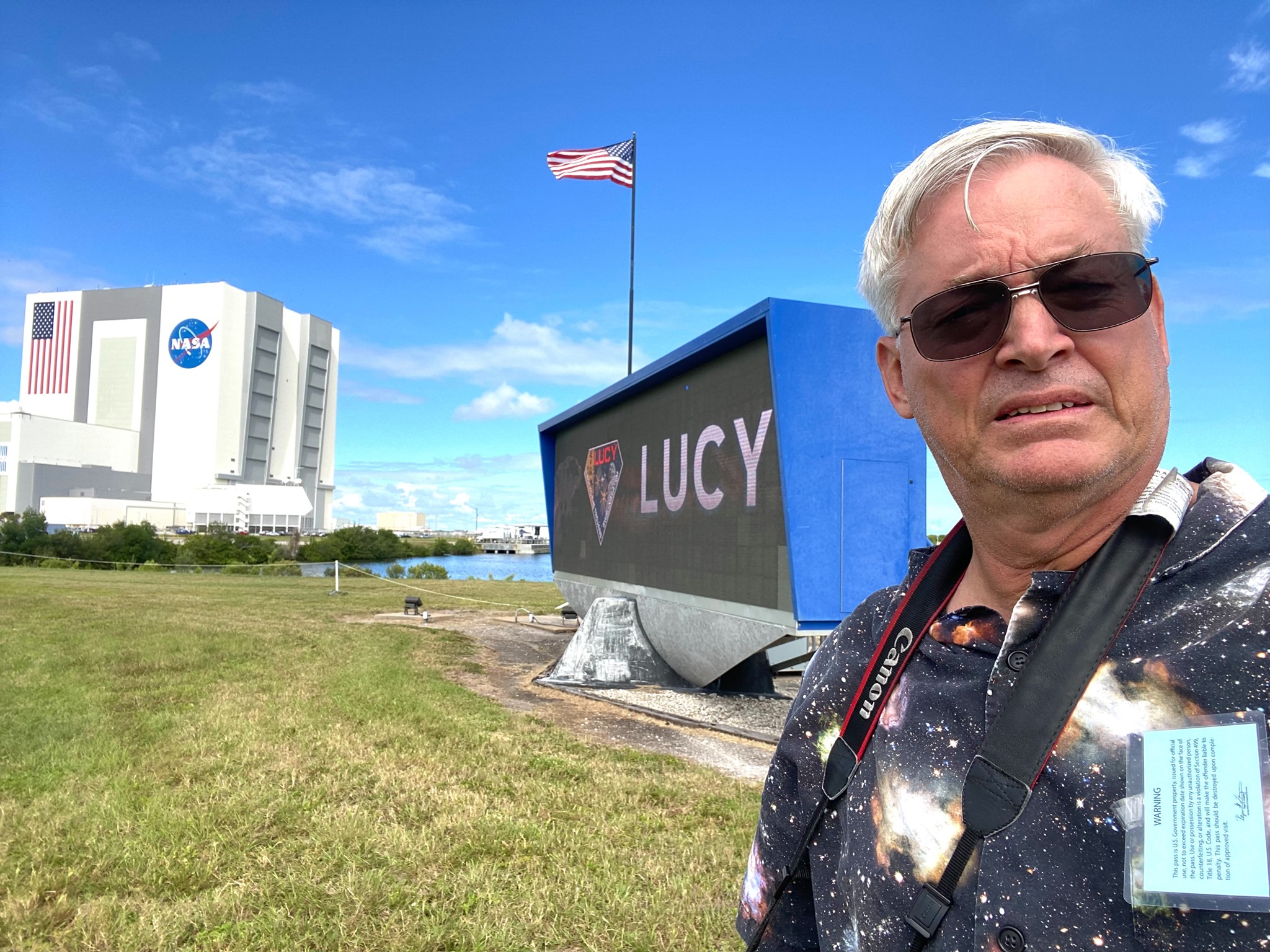
x



